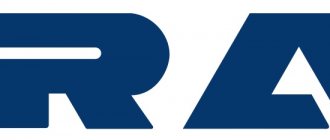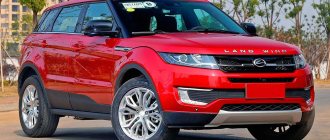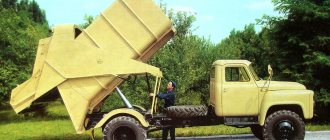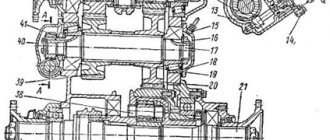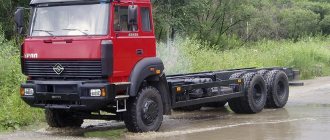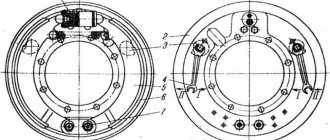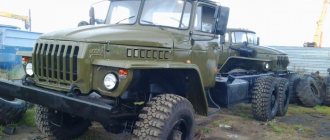In the country of the Soviets, everyone understood that they needed to invest in progress and technical weapons. And not only with direct cash injections, but also with materials, experience, personnel training, etc. A striking example is the plant of the Automobile Moscow Society (AMO), which dates back to 1916. Then the revolution happened, then the authorities had little time for industrial development due to the civil war.
But since 1926, the enterprise began to develop at an accelerated pace. By the beginning of the Great Patriotic War, it was a plant equipped with modern equipment at that time, where they produced excellent equipment for civil and military purposes. In November 1941, the Moscow plant was evacuated, dispersing production across several cities. One of them was Miass. This is how the Miass Automotive Plant was born, which later became an automobile plant.
Already in Soviet times, Ural trucks were famous for their indestructibility and cross-country ability. Of course, not just anything was sent to the needs of the Ministry of Defense, so the designers constantly improved the equipment. After perestroika, hard times came for many industrial enterprises. But none of the Russian automobile plants was able to move Ural from the pedestal of the leader in supplying both the military and oil and gas industries.
And the management of the enterprise did not give up. Despite the decline in demand for trucks, the plant reoriented itself to market demands and began producing non-core products. After the difficult 1990s, production created reference assembly areas, reducing costs and speeding up productivity.
Story
The history of the Ural Automobile Plant began as a result of the evacuation of industrial enterprises during the Great Patriotic War. Many workshops moved to the rear areas of the USSR, one of which was the Moscow Automobile Plant named after Stalin. Evacuation of a large industrial enterprise was a difficult task. And since it was not possible to locate the plant in one place, it was decided to divide the Soviet auto giant into separate independent enterprises, which in the future would produce various parts and components of cars.
Story
The evacuation took place in a short time. The archives mentioned that in the fall of 1941 a decision was made to urgently move industrial enterprises in Moscow to Ulyanovsk. But later plans for the location of the factory workshops changed, and the equipment was completely moved to Miass. This is how several automobile industry enterprises appeared in Miass. And the automobile engine plant became the main enterprise of a new industry for Ural.
Due to the shortage of cars in the country, the State Defense Committee decided to repurpose the plant for the production of military equipment. The first ZiS-5V vehicle was produced in July 1944 and for many years was considered the main model of the enterprise. In the same year, the Miass plant was renamed the Ural Automobile Plant named after Stalin. Hence the decoding “UralZiS”, which means the abbreviated name of the plant.
After the end of the war, the plant began producing trucks and dump trucks, which were required to restore the national economy. This is how a self-developed car appeared under the UralZiS-353M brand, which in 1958 was put into production under a different name - UralZiS-355M. The truck has established itself as a reliable vehicle with high load capacity, high-torque and, at that time, considerable comfort.
In 1962, the automobile company received a new name - . From that moment on, previously produced cars began to be discontinued, and the abbreviation “ZiS” disappeared from the name of the car. The transition to a new truck design has begun.
Ural - brand history
More than half a century of history of the Ural Automobile Plant began with the decision of the State Defense Committee on November 30, 1941 to organize in the city of Miass automobile engine and foundry production, evacuated from the Moscow Automobile Plant named after Stalin (ZIS). In the frosty winter of 1941, equipment was being installed day and night, right from the “wheels”, in the open air. At the same time, production buildings were erected, and already in March 1942, the first workshop of the new plant began operating. In April 1942, the first engines and gearboxes were assembled.
The country needed cars, and by decision of the State Defense Committee on February 14, 1943, the plant was converted into an automobile plant. The provincial city of merchants, artisans and gold miners becomes the Ural capital of trucks. The first Ural car "ZiS-5V" rolled off the assembly line on July 8, 1944.
On July 20, 1944, the first batch of cars from the new automobile plant was sent to the front. On September 30, 1944, the thousandth car rolled off the assembly line. In the year since the production of the first cars, the factory team sent 6,800 cars to the front and to the national economy. Ural trucks and the famous Katyushas mounted on them fought on all fronts of the Great Patriotic War, bringing the victory of our people closer.
In the post-war years, the plant began producing a car of its own design, the Ural-ZIS-353M.
The design is being improved, new models are being created: “ZiS-5M”, “UralZiS-355”.
Due to the shortage of liquid fuel in the country, the ZiS-21A (with a gas generator engine) was developed.
In 1954 and 1955, the Ural Automobile Plant took part in the Exhibition of Achievements of the National Economy of the USSR and was awarded VDNKh medals.
The sports history of the Ural Automobile Plant began in the fifties. In October 1957, the All-Union motor sports competitions were held in Rostov-on-Don. 98 ZIL-150, GAZ-63, GAZ-51 vehicles took part in them, including six UralZIS-355V vehicles. The athletes of the Ural Automobile Plant, who at that time did not have much experience in such competitions, showed themselves to be worthy opponents of the luminaries of motorsport that the cross-country brought together. The Ural team won all the first places. In the individual championship, the car crew consisting of driver P. Terentyev and mechanic A. Rubinstein won first place and the title of champion of the USSR.
In 1958, the production of the two-axle truck “Ural-355M” was mastered, which was successfully used in the development of the virgin lands of the Urals, Siberia and Kazakhstan.
To work in off-road conditions and for the country's army, special powerful all-terrain vehicles were required, and in 1961 the first heavy-duty three-axle all-terrain vehicles “Ural-375” came out of the factory gates. For the development of the design and introduction into production of this car, the Ural Automobile Plant was awarded a first-degree diploma from the USSR Exhibition of Economic Achievements.
Since 1962, the Ural Automobile Plant named after Stalin - UralZiS - has been renamed UralAZ.
In 1965, two-axle cars, which the plant had been producing for more than 20 years, were discontinued. Following this, the question arose of replacing the old conveyor. At the end of the year, a non-stop transition to a fundamentally new design of the Ural-375 vehicle was organized without reducing the pace and volume of production.
In 1966, for the development and improvement of production, the plant was awarded a high government award - the Order of the Red Banner of Labor.
In the mid-60s, the Ural Automobile Plant entered the international market with the new Ural-375 truck. The first batch went to Mongolia, followed by two batches of cars to the German Democratic Republic. In 1969, the Ural-375D, demonstrated at the international Leipzig fair, was awarded a gold medal and a 1st degree diploma. In 1972, this car was awarded the highest category of quality, and in 1973 - the state Quality Mark - a symbol of technical excellence of that time.
In January 1970, the Main Exhibition Committee of VDNKh of the USSR awarded the Ural Automobile Plant a first-degree diploma for the development of the design and introduction into production of all-terrain trucks "Ural-375YU", designed to work in tropical climates, and "Ural-377K" for working in conditions Far North.
In 1976, the Ural Association for the Production of Trucks was created on the basis of the Ural Automobile Plant. In addition to the head enterprise, it included the Chelyabinsk Forging and Press Plant, the Chelyabinsk Machine-Building Plant of Automotive Trailers and the Posevninsk Spare Parts Plant.
At the end of 1976, the first prototypes of the Ural-5920 snow and swamp transporter were manufactured. In 1981, the first industrial batch of this equipment was produced for the Ministry of Oil Industry. Snow and swamp-going vehicles have high cross-country ability in difficult off-road conditions and are used year-round for field work.
In 1977, the Ural Automobile Plant launched production of a new model, the Ural-4320, with a diesel engine, which marked the beginning of the dieselization of Ural vehicles. A number of modifications of the vehicle are being developed: the Ural-4320 with a load capacity of seven tons, the Ural-43202 truck tractor for towing semi-trailers with a total weight of 18.5 tons, a Ural-4320 truck tractor for towing semi-trailers with a total weight of 15 tons, operation in the Far North and southern regions. In 1978, prototypes of tractors for the Ural-6002 timber road train were prepared in the experimental workshop. By the beginning of 1979, prototypes of the Ural-43201 vehicle appeared for use in the Far North. It used tires from the Omsk plant, suitable for operation in 60-degree frosts. In 1983, the Ural-4320 car and its modifications were awarded the State Quality Mark.
Currently, "Ural-4320-01" is the base model of the numerous "Ural" family with a wide range of special equipment that are used in various areas of the national economy. In recent years, rotational buses, cranes, tank trucks, fuel tankers, fire trucks, repair shops, and a variety of special equipment for the timber industry and oil and gas complexes manufactured on the Ural chassis have become very popular among consumers. For road workers and municipal services, auger snow blowers and complex municipal vehicles of the “Troika-2000” type are produced, which perform more than ten operations to improve roads and adjacent areas. Special equipment and weapons installed on the Uralov chassis for various branches of the Russian Defense Ministry, Federal Border Guard Service, Ministry of Internal Affairs, and Ministry of Emergency Situations amount to about 400 items.
In the eighties, the Ural-5557 agricultural vehicle was developed and introduced. The special transport and technological dump truck was capable of operating at temperatures from 40 degrees hot to 45 degrees cold, and could be used in Central Asia and the North. Possessing high cross-country ability and optimally selected transmission gear ratios, it could work with various agricultural machinery in the fields. "Ural-5557" successfully worked as part of a road train, had high productivity due to its high speed (70 km per hour) and large load capacity (14 tons). The truck chassis was used as a base for installing various bodies and special equipment. Wide-profile tires with pressure regulation ensure high maneuverability of the machine on soils with different densities. New ventilation and heating systems, automatic remote control of the platform's sides, which can be tilted by a signal from the cab, have created comfortable working conditions for the driver in any conditions.
In 1983, small-scale production of Ural-5557 began.
In 1985, for great success in fulfilling government tasks for the production of automobile equipment, the Ural Automobile Plant was awarded the Order of the October Revolution.
On February 21, 1986, the millionth Ural car was produced.
In 1989, the automobile plant produced the first four-axle vehicle, the Ural-5323, with a unified KamAZ cab.
In 1992, Ural cars took part in the ultra-marathon and, having successfully finished the Paris-Moscow-Beijing rally raid, once again confirmed their quality and reliability.
In the winter of 1994, UralAZ took part in a large motor rally from London to New York, where the Urals drove a caravan of Ford cars through the Cold Pole, Siberia, Yakutia, and the snowy impassability of Chukotka to the Bering Strait without a single breakdown.
In April 1994, the Open Joint Stock Company UralAZ and the Italian company, together with the Russian concern Gazprom, created the joint venture IVECO-URALAZ. The joint venture produces vehicles with a carrying capacity of up to 23 tons (55 tons as part of a road train), adapted to the climatic conditions of all regions of Russia. The production complex is designed to assemble 3,000 cars and 9,000 cabins per year.
In 1997, the DEUTZ-Ural-Diesel joint venture was created to produce the model 1015 engine under a German license. On May 18, 1999, a protocol was signed in which UralAZ and the German side agreed to continue cooperation and to develop programs to promote Ural vehicles with Deutz engines in countries where both parties are most fully represented on the market.
The Ural Automobile Plant is the first and, to date, the only automobile assembly plant in Russia that received a certificate (Germany) in July 1995 for compliance with ISO 9000 series standards for all aspects of its activities.
In April 1996, Gosstandart of Russia confirmed the compliance of the quality system of the Ural Automobile Plant in relation to the Ural car with the requirements of GOST R ISO-9001-96.
In the fall of 1998, in order to improve the financial situation at the plant, an external management procedure was introduced. In a short period of time, the management team managed to increase production output, liquidate the secondary car market, and switch to a custom production planning method.
In April 1999, a recertification audit conducted at the automobile plant by the commission of the Russian Federation Committee for Standardization, Metrology and Certification confirmed the compliance of the UralAZ quality system with the requirements of GOST R ISO-9001-96.
In 1999, the Ural Automobile Plant team was the first Russian team to take part in the international competition “Europe Truck-Trial”. The debut of the Miass athletes turned out to be successful: in the stone quarries of Austria, Germany, Spain and France, “Ural” coped with most of the obstacles and competed on equal terms with its rivals. The mayor of the German city of Osnabrück established an incentive prize - a cup for the team of the Ural Automobile Plant that traveled the longest distance to participate in the competition. In 2000-2001, the Ural Automobile Plant team successfully performed in European competitions and in the Commonwealth Championship "Yarovit Truck-Trial"
On June 4, 1999, as part of its participation in the economic life of the region, the management of UralAZ initiated and organized a meeting at which a general agreement “On the principles of development of intraregional cooperation” was concluded. The agreement was signed by the heads of the region, cities and large industrial enterprises.
An Italian line of cataphoretic priming of cabs has been launched in the car assembly production. The warranty period for the product is increased to 10 years.
In November 1999, the foundry put into operation the Swiss automatic molding line "Georg Fischer" for casting parts from high-strength cast iron. Its productivity is 2400 tons per year.
Since 1999, the Ural Automobile Plant has been implementing a comprehensive automated enterprise management system from the Dutch company BAAN, which will allow specialists to have reliable information about all processes occurring in the enterprise in real time.
In December 1999, the Ural-53236 with a cabover cab, produced jointly with the Italian concern Iveco, went into production.
At the end of 1999, a new workshop of van bodies was put into operation at the Ural Automobile Plant, annually producing up to 1000 Ural-3255 rotation buses designed for transporting people off-road. To meet the needs of the workshop, new equipment was put into operation in April 2000 - a gas-plasma cutting machine installation.
At the end of 1999, UralAZ entered the top hundred best companies in Russia in the Reputation category.
In June 2000, the Ural Automobile Plant became a leader among mechanical engineering enterprises in terms of volumes of products sold.
In June 2000, as part of the restructuring, a subsidiary, Avtomobilny, was created.
At the end of 2000, representatives of the automobile plant took part in the off-road vehicle race “Russia’s Path to the 21st Century - Between Europe and Asia,” organized by the popular magazine “Behind the Wheel.” The office car "Ural-3255" together with the participants of the race traveled from Miass to the polar village of Kharyaginsky.
Based on the results of the annual rating, the International Association of Business Partners ADM (AUSTRALIANA DISCOVERY MARKET) noted the Ural Automobile Plant as the enterprise of the year 2000.
In February 2001, the Russian Institute for Testing and Certification of Arms and Military Equipment (InIS) awarded the Ural Automobile Plant a military register certificate.
At the end of the first quarter of 2001, the hundredth rotational bus “Ural-3255-0010” with a van body of its own production rolled off the assembly line of the Ural Automobile Plant. The anniversary car was sent to consumers in one of the large cities of the Tyumen region - Salekhard.
In June 2001, in collaboration with OJSC Uralvagontripsep, serial production of a road train based on the Ural-44202-31 began for transporting tracked and wheeled vehicles, as well as other military equipment on all types of roads and off-road.
In 2001, the production of Ural cars with an engine that meets the international environmental requirements of Euro 2 began. In 2002, 1000 of these vehicles will be assembled at the automobile plant.
In 2001, the company managed to solve the problem of finding a strategic partner - Avtomobilny OJSC became part of the largest Russian auto holding RusPromAvto.
In January 2002, the production of a combined road vehicle (KDM) based on the Ural-43206 (4x4) chassis began. A vehicle equipped with equipment for operation in summer and winter will occupy a niche of relatively inexpensive special equipment aimed at domestic consumers. By the end of 2002, a combined road vehicle based on the Ural vehicle chassis will be put into mass production.
In February 2002, the assembly line assembly of the Ural-5323 vehicle with increased payload capacity and a comfortable cabin, jointly produced by IVECO-UralAZ, began.
In August 2002, the Ural-636142-02 truck tractor received the main prize in the “Best Off-Road Truck” competition organized by the Commercial Transport magazine as part of the seventh international exhibition “Motor Show - 2002”.
In September 2002, for the first time in the history of motor sports, the Russian team became the European champion. This victory belongs to the automobile - the crews Alexander Zhmaev - Sergey Petelin (Ural-5323, category C5) and Valery Knyazev - Ivan Bolotov (Ural-4320, category C4) took first place in the overall standings at the international competitions "Europe Trak- Trial."
In January 2003, the 1000th Ural rotation bus was produced in the van body shop.
In May 2003, a prototype of the Ural-55571-44 dump truck was prepared, equipped with a new hooded cabin with an integral type tail. In August, the dump truck was awarded the third prize by Comtrans magazine in the “Best SUV 2003” category.
In August 2003, a tripartite agreement was signed between Avtodizel Automobile OJSC (Yaroslavl, RusPromAvto holding) and the Bosch company. The result of fulfilling its conditions will be the creation of the Ural car, whose power unit will meet Euro-3 requirements.
In February 2004, the program for the transition of all manufactured products to comply with the requirements of Euro-2 environmental standards was fully completed.
In August 2004, at the Moscow international exhibition MIMS-2004, new road series vehicles were presented: the Ural-6363 (4x2) flatbed truck and the Ural-63645 (6x4) dump truck. The first batch of such cars will be sold in 2005.
The company's revenue for 2008 amounted to 18.59 billion rubles. (for 2007 - 17.61 billion rubles), net loss - 4.3 billion rubles. (in 2007 - net profit of 3.774 billion rubles).
As of 2015, exports to non-CIS countries amounted to about 7,000 vehicles, 35% of total Ural sales went to foreign buyers in 12 countries, with Egypt accounting for 94% of deliveries. In 2016, it is planned to expand the geography of exports to 20 countries.
What vehicles were produced?
For many years, the main brands of Ural cars were the UralZIS series. They underwent minor modifications, but this was not enough to produce a decent truck. And then it was decided to develop a new car using the technologies of the Scientific Automotive Institute.
Before 1991
Since the 60s, Uralmash has been producing off-road trucks called Ural-375. In 1963, they were modernized and received a new name - “375D”. These vehicles are superior to even modern trucks in many respects. They have found application in the armed forces, as well as in the national economy, including the oil and geological industries.
"Ural-375D"
In April 1977, work began at the Ural plant on a new “waterfloating” family of trucks – “Susha”, which were classified as secret equipment. These Ural cars were able to move on the surface of the water due to the installation of a special wave-reflecting shield. Moreover, outwardly they could not be distinguished from land trucks.
Since 1991
After 1991, the official manufacturer began producing military, civilian and specialized vehicles, which are equipped with onboard and self-unloading bodies, special loads, fifth wheels: “Tornado G” based on the “Ural-4320”, models 43206, 63704, 6361, 44202-59.
Modern "Ural"
For the 80th anniversary of its founding, which, by the way, will be celebrated on November 30, we came to visit by car. Driving along the main highway of Miass, you immediately understand that this is a city of mechanical engineers. Even the avenue bears the proud name of Avtozavodtsev. The road ends at the entrance of the plant, connected to the 12-story administrative building. Under the roof, there are advertisements for hiring specialists in a “crawling line”.
We get to the main conveyor belt by bus. Otherwise, it’s easy to get lost in the vast territory. We enter the production workshop, and the first thing that catches your eye is cleanliness. It’s quite noisy inside, so we are given headphones in which the guide’s voice will be heard.
We walk through a room with an area of 120,000 m2, where 24 posts are located. The assembly line is not particularly crowded, although the enterprise employs over 5 thousand specialists in total. From time to time, finished chassis pass by, but the workers pay almost no attention to them, as well as to our delegation of journalists and partners of the Ural Automobile Plant. Here everyone is focused on their work.
Assembly of frames, bridges, cabins and superstructures is underway. Next, the features of the finished chassis emerge; all that remains is to install the engine, gearbox, carry out the electrical wiring, and connect it so that everything interacts. After assembly, the car is carefully inspected, tested on the roads, and then driven into the box for another inspection.
The plant produces over 8,000 chassis per year, and it is planned to assemble at least 8,700 units this year. In total, the company’s product range includes more than 300 modifications of the Ural Next, Ural-M, 6370, 9535 and the famous 4320 series. By the way, they plan to remove the hooded cabs for the latter from mass production next year, leaving production only on special orders.
The bet is on cabover chassis. Our regular readers are already familiar with this promising direction from publications from the ComTrans-2019 and bauma-STT-2021 exhibitions.
